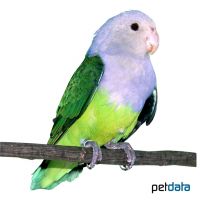Grey-headed Lovebird (Agapornis canus)
| Grey-headed Lovebird Agapornis canus | |
|---|---|
| Name | Grey-headed Lovebird |
| Name Lat. | Agapornis canus |
| Family | Parrots |
| Family lat. | Psittacidae |
| Order | Parrots |
| Order lat. | Psittaciformes |
| Origin | Africa |
| Climate | Subtropical - tropical |
| Diet | Lovebird seed, veggies, fruits |
| Keeping | Pair, group |
| Care Level | Moderate |
| Reproduction | Cavity nest |
| Life Span | 10-15 years |
| Protection | CITES Appendix II; EC Annex B |
| Metric Units | |
| Size | 13 cm |
| Temperature | Room temperature |
| Housing | 100 x 50 x 50 cm |
| US Units | |
| Size | 5.1" |
| Temperature | Room temperature |
| Housing | 40" x 20" x 20" |
Distribution and habitat
The grayheads are native to Madagascar, the Mascarenes and the Comoros and Seychelles. They live in the evergreen forests of the coastal areas. Today they are only offered as a breeding form.
Cage size
The minimum cage size is 100 x 50 x 50 cm (L x W x H) for a pair. The cage size must not be undercut even in case of justified single keeping. For an additional 2 birds, assuming species compatibility, the floor space must be increased by 50%. The cage must be placed at a height of at least 80 cm (except aviaries) in a bright, draught-free and quiet place and should have cross-wiring or netting. Keeping in an aviary with a floor area of at least 1 m² is preferable to keeping in a cage.
Maintenance
The floor must be covered with sand, shavings of untreated wood or similar material and cleaned once a week if possible. At least 2 perches made of wood or branches of different thickness and height shall be installed in such a way as to provide the longest possible flight path and prevent soiling of the feed and water containers. A bathing facility should be available at all times, alternatively they can be sprayed with water at least once a week. In addition to hiding places (burrows or half burrows), they need climbing and occupation material, such as rings, ropes and natural branches that are harmless to health. They should be kept at room temperature.
Diet
The species-specific feed offer consists of mixed seeds, available in specialized trade as "Agapornidenfutter" in premium quality, supplemented with foxtail millet, some green panicle millet, chickweed, organic lettuce, berries, fruits, carrots, in addition fresh twigs with buds and especially for the rearing of young sprouted feed (semi-mature wheat), egg feed and soaked rusk as well as grit, sepia and vitamin lime as digestive aid. Multiple birds need multiple feeders. Water must always be available in birdbaths or in stable, open containers and, like food, must be offered fresh daily in clean containers. A varied diet promotes good health.
Reproduction and breeding
In the male, the head, neck and chest are light gray. Females have a green, or a delicate light gray head.
They breed in nest boxes (including budgerigar nest boxes) in portrait or landscape format and in hollowed tree trunks. The nesting material, such as fresh leafy plants (e.g., elderberry) is entered in the dorsal plumage. The clutch consists of 2 to 5 eggs, the incubation period is about 21 days. The breeding season is, biologically speaking, year-round. Young birds should be raised so that they are species-specific.
Species protection
They should be provided with a leg ring. The animal population must be reported in writing to the competent authority immediately after the start of keeping. Your pet store will be happy to provide you with further information.
Protection of species: WA Appendix II; EU Appendix B. The proof of purchase is the required proof of origin for the animal. Please keep it safe!
Important
In the case of outdoor aviaries, they also need a heated shelter of at least 0.5 m², which can be visited by the birds at any time. The temperature in the shelter must not fall below 10 °C and the furnishings must correspond to those of cage keeping
They may only be kept in pairs or in a group. Socialization with other small parrots is possible. In rooms, also in shelters, sufficient daylight or flicker-free artificial light (stroboscopic effect) corresponding to daylight must be provided. The lighting duration shall be 8-12 hours per day and the natural day-night rhythm shall be observed. Adequate indoor climate should be provided. If caged, they should be allowed free flight. The health condition of the birds should be checked daily.
Further literature can be found in your pet store.
References
Text: Othmar Sieberer; Image: petdata
Source: BMELV (1995): Tierschutzgutachten - Mindestanforderungen an die Haltung von Papageien; GRUMMT & STREHLOW (2009): Zootierhaltung - Tiere in menschlicher Obhut: Vögel, Verlag Harri Deutsch
- Gemäß § 21 Abs. 5 Tierschutzgesetz idgF
